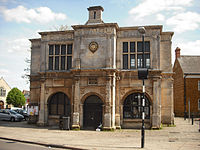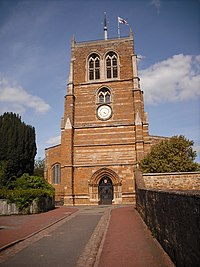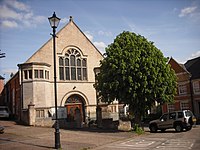Rothwell, Northamptonshire
| Rothwell | |
| Northamptonshire | |
|---|---|
| Location | |
| Grid reference: | SP8181 |
| Location: | 52°25’30"N, 0°48’4"W |
| Data | |
| Population: | 7,694 (parish est.) |
| Post town: | Kettering |
| Postcode: | NN14 |
| Dialling code: | 01536 |
| Local Government | |
| Council: | North Northamptonshire |
| Parliamentary constituency: |
Kettering |
Rothwell is a market town in Northamptonshire. It is located south of Desborough, southeast of Market Harborough, southwest of Corby and northwest of the larger town of Kettering.
The name of the town is either from Old English or Norse or a mixture of them. The leading suggestion is that the "Roth'" element is the old Nose roð meaning "red", with the Old English wielle / welle; a red well, presumably after of the area's many freshwater springs coloured red by iron in the soil.
By the early Middle Ages Rothwell, or "Rowell" as it is known locally, was already a town of some importance, dominating the then smaller settlement of Kettering (a state of affairs which persisted until the arrival in Kettering of the railway). A charter, granted by King John in AD 1204 permitting a weekly market and annual fair, confirmed the trade. Both a market and a fair are still extant. The market is held every Monday and the fair, called "Rowell Fair", takes place on Market Hill during the week following Trinity Sunday.
The town has a rich history and possesses a large parish church, the longest in the county and complete with bone-crypt and the Market House built by Thomas Tresham in 1578. Rothwell was once one of the two largest towns in Northamptonshire, the other being Northampton (and Stamford, Lincolnshire if the trespass of its southern edge into Northamptonshire may claim it honorary status as a Northamptonshire town).
Contents
Rowell Fair
In 1204 King John issued a royal charter to Richard Earl of Clare permitting him and his heir so hold a market in Rothwell every Monday.
The granting of the charter is celebrated annually by the week-long Rowell Fair. The fair is opened on the first Monday after Trinity Sunday each year by the Proclamation, which in 2012 will take place on 4 June.
Starting at 6am at the west door of Holy Trinity church, the bailiff of the Lord of the Manor rides through the town accompanied by a guard of halberdiers and the Rowell Fair Society Band. At each public house he pauses to read aloud the charter. At the conclusion of each reading the crowd cheers "God save the Queen and the Lord of the Manor" and the band plays the God Save the Queen. The proprietor of the public house then serves the bailiff and his guards with drinks including the traditional Rowell Fair rum and milk. The local townspeople then attempt to disarm the halberdiers before the party moves on to the next public house.
Pubs in the town traditionally remain open after the proclamation, and so much merriment is to be had all through the morning. It has been suggested, however that the traditional route for the fair should be moved to avoid town-centre traffic congestion.
The Market House
On Market Hill stand the Market House, designed by William Grumbold for the somewhat eccentric Thomas Tresham (1545–1605) who was also known as "Thomas the Builder" because of his passion for strange and unusual buildings. As a Recusant at a time of religious persecution, he was to spend long periods in prison for his obstinacy in clinging to Rome and, unable openly to practise Roman worship, he encoded symbols of it into his buildings. The Rushton Triangular Lodge reflects the trinity and Market House is cross shaped. Tresham gifted the Market House to the town, of which he was Lord of the Manor, but although work started in 1577 it would be 300 years before it was finished by local architect J A Gotch.
Churches
Holy Trinity Church
Since 12 June 1950, the church has been designated a Grade I listed building.[1]
Although the south chancel wall, with its corbel table, complete with three round-headed windows date from the 11th century and the west tower dates from the 1170s, most of the church is 13th century. The tower at one time had a spire, but in 1660 this collapsed, severely damaging the nave.[2]
The church is 173 feet long, making it the longest church in Northamptonshire.
The church organises a wide range of events including, in June 2013, a concert by noted British accordionist John Kirkpatrick.[3]
The church has one of only two known bone crypts or "charnel houses" in the country, containing the remains of around 1,500 people.
Holy Trinity has seven, late 15th century misericords, along with one from the 1980s, which is a floral decoration in memory of Doris Willcox who died in 1974.
The United Reformed Church
Built in 1735, Rothwell United Reformed Church has a simple facade but has a remarkable interior in a sophisticated classical style. The history of Non-Conformism in Rothwell streches as far back as 1655.
Sport and leisure
- Football:
- Rothwell Corinthians FC, who play at Seargeant's Lawn
- Rothwell Town FC (a team now without a home, having lost their pitch in 2012)
Outside links
- BBC Coverage of 800th Rothwell Fair
- Rowell Fair Society
- Rothwell Town
- Rothwell Holy Trinity
- Desborough & Rothwell Photographic Society
References
- ↑ "Church of Holy Trinity, Rothwell". britishlistedbuildings.co.uk/. http://www.britishlistedbuildings.co.uk/en-398811-church-of-holy-trinity-rothwell-northamp. Retrieved 2 June 2013.
- ↑ "A Short History". rothwellholytrinity.org.uk. http://www.rothwellholytrinity.org.uk/ashorthistory.htm. Retrieved 2 June 2013.
- ↑ "John Kirkpatrick". rothwellholytrinity.org.uk. http://www.rothwellholytrinity.org.uk/events.htm. Retrieved 3 June 2013.


